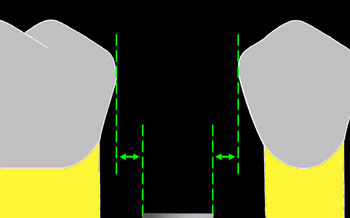Running room (dentistry)
- Not to be confused with the Running Room, an athletics apparel company.

In implant dentistry, running room refers to the distance between the platform of a dental implant and the gingival margin. The term was coined by Jonathan Zamzok, a Manhattan prosthodontist, in the late 1990s.[1]
Adequate running room is necessary to allow the implant-supported crown to exhibit a tooth-shaped contour despite the circular nature of implant platforms.[2] For example, the mean mesial-distal dimension of a maxillary central incisor at the points at which it contacts the adjacent teeth is 8.6 mm, but the mean mesial-distal dimension of the same tooth at the cementoenamel junction (CEJ) is 6.4 mm.[3]
As the anatomical crown and root tapers towards the apex, the mesial-distal dimension decreases, and so the mean mesial-distal dimension at the marginal crest of bone, which lies approximately 2 mm apical to the CEJ, is smaller. The tooth has the apico-coronal distance from the marginal crest of bone to the contact point in order to increase from the much narrower mesial-distal dimension to the greater mesial-distal dimension, and this distance is partially subgingival (below the gum line) and partially supragingival (above the gun line). Running room refers to this subgingival apico-coronal distance.
In general, it is recommended that implants be given approximately 3mm of running room in compliance with the rule of thumb that implants should be placed as deep as necessary and as shallow as possible.[4]
When implants are placed too palatally or lingually due to aberrant anatomical landmarks, bone resorption or surgical error, it is wise to place the implant more apically to increase the available running room in order to allow for a more convex emergence profile and avoid a buccal ridge-lap of the prosthetic crown in fixed partial denture cases.[4]
References
- ↑ Zamzok J. Nonsurgical soft tissue sculpting. Alpha Omegan 1997;90:65-69
- ↑ Smith RB, Tarnow DP. Classification of molar extraction sites for immediate dental implant placement: technical note. Int J Oral Maxillofac Impl 2013;28:911-916
- ↑ Scheid RC, Woelfel JB. Woelfel's Dental Anatomy: its relevance to dentistry, Lippincott Williams & Wilkins, 2007 ISBN 0781768608
- ↑ 4.0 4.1 Greenstein G, Cavallaro J. The relationship between biologic concepts and fabrication of surgical guides for dental implant placement. Compendium 2007;28(4):130-137